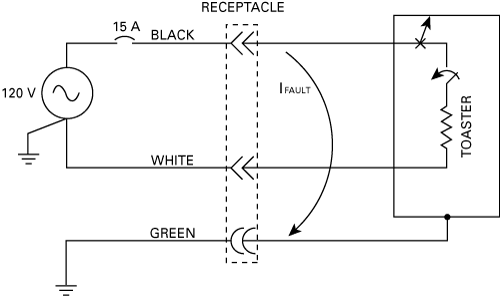
What is a Ground Fault?
A ground fault is an inadvertent contact between an energized conductor and ground or equipment frame. The return path of the fault current is through the grounding system and any personnel or equipment that becomes part of that system. Ground faults are frequently the result of insulation breakdown. It’s important to note that damp, wet, and dusty environments require extra diligence in design and maintenance. Since water is conductive it exposes degradation of insulation and increases the potential for hazards to develop.

What is the purpose of grounding?
The primary purpose of grounding electrical systems is to provide protection against electrical faults. However, this was not realized until the 1970’s. Until then, most commercial and industrial systems were ungrounded. Although ungrounded systems do not cause significant damage during the first ground fault, the numerous disadvantages associated with ground faults resulted in a change to the grounding philosophy. There are other advantages for a grounded system, such as reduction of shock hazards and protection against lightning.
Electrical faults can be broken down into two categories: phase-to-phase faults and ground faults. Studies have shown that 98% of all electrical faults are ground faults (Source: Woodham, Jack, P.E. “The Basics of Grounding Systems” May 1, 2003). Where fuses can protect against phase-to-phase faults, additional protection, such as protection relays, are typically required to protect against ground faults.
|
LEADING INITIATORS OF FAULTS
|
% OF ALL FAULTS
|
|
Exposure to moisture
|
22.5%
|
|
Shorting by tools, rodents, etc.
|
18.0%
|
|
Exposure to dust
|
14.5%
|
|
Other mechanical damage
|
12.1%
|
|
Exposure to chemicals
|
9.0%
|
|
Normal deterioration from age
|
7.0%
|
Table 1
As as example, in the toaster circuit below, the black or hot wire is shorted to the metal casing of the toaster. When the circuit closes, all or part of the current is channeled through the toaster frame and then the green ground wire. When sufficient current flows (typically 6 x 15 A = 90 A), the circuit breaker will open. A protection relay could be installed to detect currents as low as 5 mA, which would open the circuit breaker at a significantly lower level, hence, much quicker than the traditional circuit breaker.

Although the example above shows a solidly grounded single-phase circuit, the philosophy is the same on three-phase circuits discussed later. Relays and monitors are specifically designed to look for the leading initiators shown in Table 1 by detecting low-level changes in current, voltage, resistance or temperature.
What are some issues that cause a ground-fault relay to trip accidentally?
Harmonics and higher-frequency noise, especially at the third harmonic, appear as fault current. Electrical noise is a growing problem as more users utilize variable frequency drives, inverters, battery storage/UPS, and even LED lighting. To avoid nuisance trips, select a high-quality ground-fault relay that removes harmonic frequencies and other noise from its measurements.
What are the benefits of using a grounded system over an ungrounded system?
One of the major concerns of an ungrounded system is the risk of transient overvoltage. An intermittent or arcing ground fault can result in a buildup of voltage on the system, stressing and deteriorating insulation and resulting in voltages as much as 6 times higher than the nominal system voltage. Another benefit of a grounded system is the ease of locating a ground fault. Ungrounded systems do not allow ground-fault current to flow on the first fault, but instead reduce the voltage on the faulted phase across the entire system. Grounded systems can utilize current-based ground-fault relays to locate exactly where the fault is.
In terms of faults, how many kinds of faults can there be?
There are 3 different types of faults: phase to phase faults, three phase faults and ground faults. Phase to phase faults or “short circuits” are found within a device when an overloaded electrical current flows through a wire and burns it out. According to the Dunki-Jacobs textbook 95% of faults are ground faults, 4% are considered phase to phase faults, and 1% are considered three phase faults.
What do ground-fault relays do?
In electrical circuits, current returns to its source. A current-based ground-fault relay
may look for ground-fault current in one of two ways:
1.) Zero sequence. Here, the relay looks at the phase conductors to ensure that all
current coming from the source returns on those same conductors. If some of the
current is returning to the source through a different path (usually ground), the
ground-fault relay will detect this difference and, if it exceeds a pre-determined
amount for a pre-determined amount of time, the ground-fault relay will operate.
2.) Direct measurement. A ground-fault relay can also read the current in the
connection between the transformer neutral and ground (even with a neutral grounding
resistor). A ground fault anywhere in the system will return current
through this path.